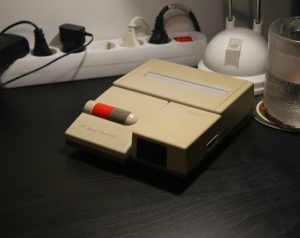So I kinda figured the first post I’d make on my blog would be about my hardware. More specifically, what I play my NES titles on. Last September, I finally got a package from my friend containing AV Famicom, which is the Japanese equivalent for model 2 NES (with small differences I’ll get later). So to start with, here’s a little bit of history about Famicom and NES.

To start with, Nintendo released their Famicom home console in Japan on 15th of July, 1983 (Wikipedia) following the success of their arcade titles and Game and Watch games. This console featured two hardwired controllers with 8/6 buttons (player 2 had microphone instead of start and select buttons), rf output only and used cartridges to load games. Later on, the Nintendo decided to release this console in the US (after the video game crash that happened in North America during the 80’s), with redesigned case and controllers, alongside with composite output for video. Later on, they decided to release this new console to Europe, first through Mattel, later on by themselves.
After the NES heyday during the late 80’s, Nintendo started to lose market share to the new 16-bit consoles, Sega Mega Drive (known as Genesis in the NA market) and PC Engine (Turbographics-16 respectively). They responded with releasing their own Super Famicom (known as Super Nintendo Entertainment System, aka. SNES for us not living in Japan) in 1991. Nintedo also released cost-down version of their NES in 1993. This “new” system featured new casing with top loading cartridge slot instead of the NES toaster mechanism and RF output only.

This new redesign was also released in Japan few months later, alongside with few technical differences. The Japanese model 2 Famicom had the Famicom expansion port on the side, flat top case to fit the Famicom Disk System RAM adapter and most importantly composite av output through the Nintendo’s multi-out port (first featured in Super Famicom/SNES and used all the way to Nintendo Wii).
I wanted this AV Famicom mostly because three reasons, first of which was that the composite output is much cleaner than on modified Famicom, and the top-loading cartridge system was less prone to mechanical failure than with the original revision of NES. The last reason is that since the NES runs through AC power, the North American consoles run actually bit faster due to the differences in mains electricity (NA is 120volts at 60 Hz whereas EU is 230v at 50Hz). The Famicom takes in DC power (around 10 V and 1 amp), and runs at same speed that it’s North American counterpart. These differences in clock speed can lead to games running slower on European consoles, unless the release was specifically reworked around the differences to run at same speed. I also wanted to play imported games from Japan so overall I figured I’d avoid headache by using famicom with cartridge adapter (the only thing needed to play NES games on Famicom is simple 72-pin to 60-pin cartridge adapter). Incidentally, my friend imported these consoles to Finland, and I bought one off from him.
On the next post I’ll talk more about the console itself and what kind of setup I have.
